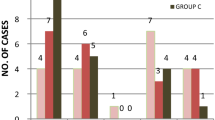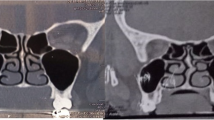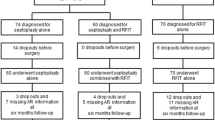Abstract
Purpose
To investigate the asymmetry of the inferior turbinate (IT) in patients with nasal septum deviation (NSD).
Methods
The paranasal sinus computed tomography (CT) of 100 patients with NSD were retrospectively investigated from February 2018 to December 2019. The thickness of IT, IT mucosa and IT bone, the distance between the IT and the midline were measured on both the concave and convex sides, and which correlation with NSD was analyzed.
Results
The widths of the IT, IT bone and IT medial mucosa on the concave side were larger than those on the convex side (all P < 0.05). The distance from the IT and IT bone to the midline on the concave side was smaller than those on the convex side (P < 0.05, respectively). The degree of NSD had a negative correlation with the widths of the IT and IT bone on the convex side, and the distance between the IT and the midline on the concave side; and a positive correlation with the distance from IT and IT bone to the midline on the convex side, and IT mucosa thickness on the concave side (all P < 0.05).
Conclusion
The asymmetric IT width is mainly caused by both hypertrophies of the IT mucosa on the concave side and atrophy of the IT bone on the convex side. Therefore, during the surgery of nasal ventilation reconstruction, the IT on the convex side are suggested to be protected from intervention. In contrast, it is necessary to lateralize the IT bone and reduce the IT submucosal tissue on the concave side. However, routine excision of the IT bone is not recommended.




Similar content being viewed by others
References
Koo SK, Kim JD, Moon JS, Jung SH, Lee SH (2017) The incidence of concha bullosa, unusual anatomic variation and its relationship to nasal septal deviation: a retrospective radiologic study. Auris Nasus Larynx 44:561–570. https://doi.org/10.1016/j.anl.2017.01.003
Liu J, Yan Z, Zhang Z, Wang N (2020) Septoplasty alone is not suitable for the most of structural nasal obstruction. World J Otorhinolaryngol Head Neck Surg. https://doi.org/10.1016/j.wjorl.2020.05.007
Tjahjono R, Alvarado R, Kalish L et al (2019) Health impairment from nasal airway obstruction and changes in health utility values from septorhinoplasty. JAMA Facial Plast Surg 21(2):146–151. https://doi.org/10.1001/jamafacial.2018.1368
Yamasaki A, Levesque PA, Bleier BS et al (2019) Improvement in nasal obstruction and quality of life after septorhinoplasty and turbinate surgery. Laryngoscope 129(7):1554–1560. https://doi.org/10.1002/lary.27859
Han D, Zhang L (2011) Nasal cavity ventilation expansion techniques. Acta Otolaryngol 131:1244–1248. https://doi.org/10.3109/00016489.2011.615760
Most SP, Rudy SF (2017) Septoplasty: basic and advanced techniques. Facial Plast Surg Clin North Am 25:161–169. https://doi.org/10.1016/j.fsc.2016.12.002
van Egmond MMHT, Rovers MM, Tillema AHJ, van Neerbeek N (2018) Septoplasty for nasal obstruction due to a deviated nasal septum in adults: a systematic review. Rhinology 56:195–208. https://doi.org/10.4193/Rhin18.016
van Egmond MMHT, Rovers MM, Hannink G, Hendriks CTM, van Heerbeek N (2019) Septoplasty with or without concurrent turbinate surgery versus non-surgical management for nasal obstruction in adults with a deviated septum: a pragmatic, randomised controlled trial. Lancet 394:314–321. https://doi.org/10.1016/S0140-6736(19)30354-X
Moore M, Eccles R (2011) Objective evidence for the efficacy of surgical management of the deviated septum as a treatment for chronic nasal obstruction: a systematic review. Clin Otolaryngol 36:106–113. https://doi.org/10.1111/j.1749-4486.2011.02279.x
Becker SS, Dobratz EJ, Stowell N, Barker D, Park SS (2008) Revision septoplasty: review of sources of persistent nasal obstruction. Am J Rhinol 22:440–444. https://doi.org/10.2500/ajr.2008.22.3200
Singh A, Maniskas SA, Bruckman KC, Steinbacher DM (2020) Rhinoplasty using three-dimensional analysis and simulation. Plast Reconstr Surg 145(4):944–946. https://doi.org/10.1097/PRS.0000000000006687
Ural A, Kanmaz A, Inançli HM, Imamoğlu M (2010) Association of inferior turbinate enlargement, concha bullosa and nasal valve collapse with the convexity of septal deviation. Acta Otolaryngol 130:271–274. https://doi.org/10.3109/00016480903036263
Demir D, Asil K, Güven M, Kayabaşoğlu G, Yılmaz MS (2015) Assessment of the correlation between nasal septal deviation and compensatory hypertrophy of the middle turbinate. Eur Arch Otorhinolaryngol 272:2847–2851. https://doi.org/10.1007/s00405-014-3387-6
Demir D, Asil K, Güven M, Erkorkmaz Ü (2016) Does septoplasty change the dimensions of compensatory hypertrophy of the middle turbinate? J Laryngol Otol 130:554–559. https://doi.org/10.1017/S0022215116001055
Egeli E, Demirci L, Yazýcý B, Harputluoglu U (2004) Evaluation of the inferior turbinate in patients with deviated nasal septum by using computed tomography. Laryngoscope 114:113–117
Akoğlu E, Karazincir S, Balci A, Okuyucu S, Sumbas H, Dağli AS (2007) Evaluation of the turbinate hypertrophy by computed tomography in patients with deviated nasal septum. Otolaryngol Head Neck Surg 136:380–384
Korkut AY, Islim F, Gulseven Ciftci S, Dogan R, Gedikli O et al (2012) Evaluation of inferior turbinate hypertrophy in patients with congenital and traumatic nasal septum deviation. J Laryngol Otol 126:784–788. https://doi.org/10.1017/S0022215112001260
Orhan I, Aydın S, Ormeci T, Yılmaz F (2014) A radiological analysis of inferior turbinate in patients with deviated nasal septum by using computed tomography. Am J Rhinol Allergy 28:e68-72. https://doi.org/10.2500/ajra.2014.28.4007
Becker DG, Ransom E, Guy C, Bloom J (2020) Surgical treatment of nasal obstruction in rhinoplasty. Aesthet Surg J 30(3):347–380. https://doi.org/10.1177/1090820X10373357
Devseren NO, Ecevit MC, Erdag TK, Ceryan K (2011) A randomized clinical study: outcome of submucous resection of compensatory inferior turbinate during septoplasty. Rhinology 49(1):53–57. https://doi.org/10.4193/Rhino10.006
Jun BC, Kim SW, Kim SW, Cho JH, Park YJ, Yoon HR (2009) Is turbinate surgery necessary when performing a septoplasty? Eur Arch Otorhinolaryngol 266(7):975–980. https://doi.org/10.1007/s00405-008-0855-x
Samarei R, Mabarian S (2020) A randomised trial comparing the subjective outcomes following septoplasty with or without inferior turbinoplasty. Eur Ann Otorhinolaryngol Head Neck Dis 137(4):277–283. https://doi.org/10.1016/j.anorl.2020.01.024
Whyte A, Boeddinghaus R (2020) Imaging of adult nasal obstruction. Clin Radiol 75(9):688–704. https://doi.org/10.1016/j.crad.2019.07.027
Lund VJ, Stammberger H, Fokkens WJ, Beale T, Bernal-Sprekelsen M, Eloy P et al (2014) European position paper on the anatomical terminology of the internal nose and paranasal sinuses. Rhinology 24:1–34
Wright L, Grunzweig KA, Totonchi A (2020) Nasal obstruction and rhinoplasty: a focused literature review. Aesthetic Plast Surg 44(5):1658–1669. https://doi.org/10.1007/s00266-020-01710-5
San T, Muluk NB, Saylisoy S, Acar M, Cingi C (2014) Nasal septal body and inferior turbinate sizes differ in subjects grouped by sex and age. Rhinology 52(3):231–237. https://doi.org/10.4193/Rhin13.138
Williams R, Patel V, Chen YF, Tangbumrungtham N, Thamboo A, Most SP (2019) The upper airway nasal complex: structural contribution to persistent nasal obstruction. Otolaryngol Head Neck Surg 161:171–177. https://doi.org/10.1177/0194599819838262
Unadkat S, Pendolino AL, Joshi A, Bhalla R, Woolford T, D’Souza A et al (2020) A national survey of functional septorhinoplasty surgery performed in the United Kingdom: a clinician end-user questionnaire to assess current practice and help inform future practice. Eur Arch Otorhinolaryngol 277:475–482. https://doi.org/10.1007/s00405-019-05722-z
Janovic N, Janovic A, Milicic B, Djuric M (2019) Is computed tomography imaging of deviated nasal septum justified for obstruction confirmation? Ear Nose Throat J. https://doi.org/10.1177/0145561319871533
Han JK, Stringer SP, Rosenfeld RM, Archer SM, Baker DP, Brown SM et al (2015) Clinical consensus statement: septoplasty with or without inferior turbinate reduction. Otolaryngol Head Neck Surg 153:708–720. https://doi.org/10.1177/0194599815606435
Sommer F, Hoffmann TK (2019) Septoplasty-a surgical or political challenge? Lancet 394:276–278. https://doi.org/10.1016/S0140-6736(19)31241-3
Hsu DW, Suh JD (2018) Anatomy and physiology of nasal obstruction. Otolaryngol Clin North Am 51(5):853–865. https://doi.org/10.1016/j.otc.2018.05.001
Funding
The general work was supported by the Capital Medical University Student Research Innovation Project (No. XSKY2020158) and the Natural Science Foundation of Beijing Chaoyang Hospital (CYYPY201917).
Author information
Authors and Affiliations
Corresponding author
Ethics declarations
Conflict of interest
The authors have no relevant competing interests to declare in relation to this manuscript.
Ethical approval
All procedures performed in studies involving human participants were in accordance with the ethical standards of the institutional and/or national research committee and with the 1964 Helsinki Declaration and its later amendments or comparable ethical standards.
Additional information
Publisher's Note
Springer Nature remains neutral with regard to jurisdictional claims in published maps and institutional affiliations.
Rights and permissions
About this article
Cite this article
Liu, J., Qian, Z., Yan, Z. et al. Asymmetry of inferior turbinate in patients with nasal septum deviation and its significance for nasal ventilation surgery. Eur Arch Otorhinolaryngol 279, 2423–2431 (2022). https://doi.org/10.1007/s00405-021-07012-z
Received:
Accepted:
Published:
Issue Date:
DOI: https://doi.org/10.1007/s00405-021-07012-z




